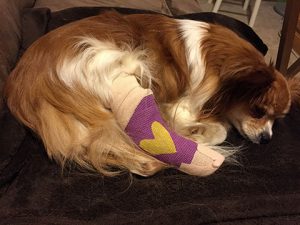It’s possible, although sometimes other techniques are more suitable. Ultimately, if your dog does have a broken bone, our vets will choose whatever is the most suitable method to get it to heal as fast as possible! 
What determines which method to use?
There are a number of factors that we take into account when deciding what the best way to manage a fractured bone is:
- Patient factors:
- Age – young animals heal faster and more effectively than older ones.
- Weight – the heavier the patient is, the more stable the fracture must be made as soon as possible, because they will struggle more to function.
- Species – cat bones heal incredibly fast compared with dogs (or people for that matter!).
- Concurrent disease – many diseases impair healing and mean that the fracture will be slower to heal.
- Fracture factors:
- Number of fragments – the more fragments there are, the more complex and difficult to repair the bone will be.
- Stability – a stable fracture is one where all the fragments lie in their anatomical positions, and where the bones will tend to remain in their correct positions.
So when do you use a cast?
Casts are suitable for stable fractures with small numbers of fragments, in young and/or small dogs and cats. A functional cast will immobilise a joint above and a joint below the fracture site, so it is only usually appropriate for limb bones.
If a cast isn’t appropriate, what are the other options?
There are a wide range of different fracture management techniques, with different pros and cons:
- Cage Rest:
- Suitable for basically stable fractures of the pelvis, ribs and occasionally skull or shoulder blades.
- Minimal movement, in a small cage, prevents stress being put on the broken bones, allowing them to heal.
- Dogs and cats become frustrated after a few days and may have to stay in confinement for 4-8 weeks, but it is a cheap and simple way of managing these fractures.
- Intramedullary Pins:
- Suitable for fractures with small numbers of fragments which is stable in rotation but not inflexion; in a long bone (such as the radius, ulna, humerus).
- A long pin is drilled into and down the bone, through the marrow cavity.
- This is a surgically simple procedure but is limited to simple spiral and oblique fractures of the larger bones of the limb.
- Plates and Screws:
- Suitable for most fracture configurations.
- A series of screws and plates are used to reassemble the bone, holding all the fragments in place.
- This allows reconstruction of multiple, complex and massively disrupted fractures; however, the screws and plates occasionally need to be removed later.
- External Skeletal Fixator:
- Suitable for most fracture types.
- An external scaffolding is used to hold a series of pins or screws in place, which immobilise each fragment in place.
- Although time-consuming and complicated surgery, it allows repairs of even the most complicated fracture patterns.
What would happen if you used the wrong technique?
The common complications of a fracture become much more likely if an inappropriate technique is used:
- Osteomyelitis – infection in the bone.
- Malunion – where the fracture heals in an abnormal position or formation.
- Delayed Union – where the bone takes an abnormally long time to heal.
- Non-Union – where the bone fails to heal at all.
What should I look for when my dog is healing and recovering?
Normal healing is associated with gradual reduction in pain, inflammation, and malaise (where the patient feels ill in themselves), and an increase in function and weight bearing. Of course, the rate of improvement will vary to some extent between patients and even from day to day in the same patient, but you should always look out for:
- Unexplained increases in:
- Pain
- Swelling
- Discharge
- More time non-weight bearing
- Lethargy, hiding or other signs of distress.
Any fracture or other severe lameness needs veterinary attention!
